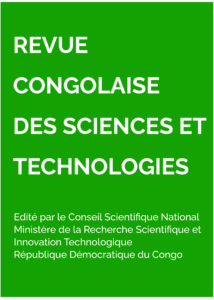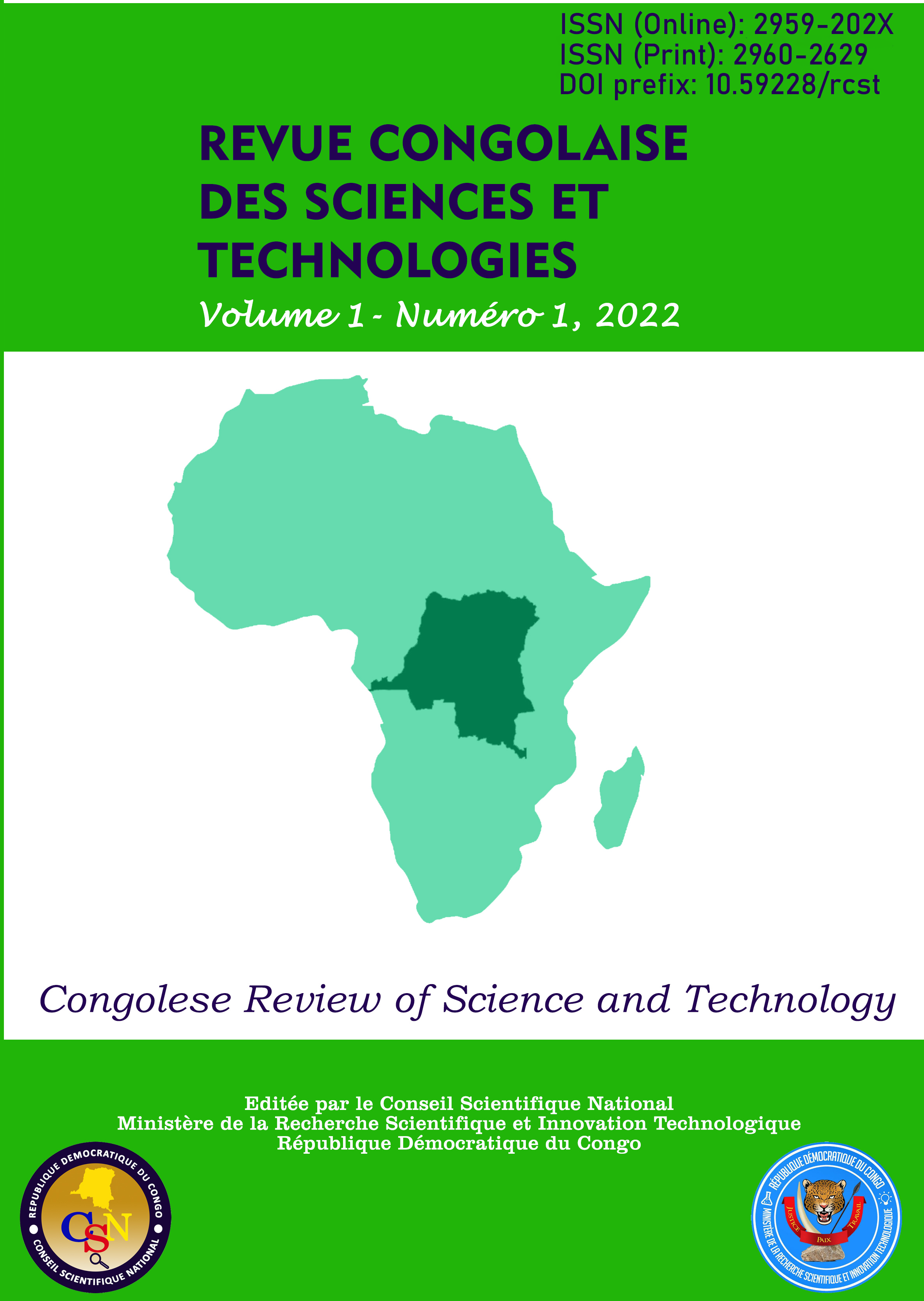Socio-economic survey and antisickling activity of Gambia tea (Lippia multiflora Moldenke, Verbenaceae) in Western Democratic Republic of the Congo
Main Article Content
Abstract
The aim of this work was to evaluate the economic potential of Lippia multiflora leaves in the western part of the Democratic Republic of the Congo, from harvesting to sale, on the one hand, and on the other hand, to evaluate the in vitro antisickling activity of the aqueous extract. To this end, a survey was carried out among the population composed of farmers and vendors involved in the harvesting and sale of L. multiflora respectively, using the snowball sampling technique. Microsoft Excel version 2010, SPSS version 20 and Origin version 8.5 Pro were used for data processing and analysis. Evaluation of in vitro anti-sickle cell activity was performed using the Emmel test. The results showed that L. multiflora is a source of income for both rural and urban population with an income of more than 300,000 CDF (150 USD) being spent on education and health. In vitro experiments indicated a high rate of sickle cell normalization. In view of these results, the domestication of this plant in some agro-ecological regions of the Democratic Republic of the Congo is highly desirable. In addition, it would also be desirable for the agro-food and pharmaceutical industries to take an interest in this sector.
Article Details
Section

This work is licensed under a Creative Commons Attribution-NonCommercial-ShareAlike 4.0 International License.
References
Altieri M.A. (1996). Agroecology: the science of sustainable agriculture. Second Edition, ISBN: 9780813317182.
APG IV (2016). The angiosperm phylogeny group. An Update of the Angiosperm Phylogeny Group Classification for the orders and followering plant: APGIV. Botanical Journal of the linnean Society, Vol. Early view, p 1-20
Bassolé I.H.N., Guelbeogo W.M., Nébié R., Costantini C., Sagnon N.F., Kabore Z.I., Traoré S.A. (2003). Ovicidal and larvicidal activity against Aedes aegypti and Anopheles gambiae complex mosquitoes of essential oils extracted from three spontaneous plants of Burkina Faso. Parassitologia; 45:23-26.
FAO (2001). « Valorisation du milieu forestier par l’homme, vers une gestion durable en Guyane », (PFNI) - GIP ECOFOR – PARIS. p63.
Lamérant G., Lebel F., Langlais G., Vézina A. (2008). Mise en valeur des produits forestiers non ligneux. Présenté par le Centre d’expertise sur les produits agroforestiers, 186 pages + Annexes.
Loubelo E. (2012). Impact des produits forestiers non ligneux (PFNL) sur l’économie des ménages et la sécurité alimentaire: cas de la République du Congo. Thèse de doctorat, Economies et finances. Université Rennes 2. p261
Masengo C.A., Bongo N.G., Robijaona B., Ilumbe G.B., Ngbolua K.N., Mpiana P.T. (2021a). Etude ethnobotanique quantitative et valeur socioculturelle de Lippia multiflora Moldenke (Verbenaceae) à Kinshasa, République Démocratique du Congo. Revue Marocaine des Sciences Agronomiques & Vétérinaires 9(1): 93-101.
Masengo C.A., Inkoto C.L., Munsebi J.M., B.L. Mandjo B.L., Mpiana P.T., Ngbolua K.N. (2021b). Connaissance et usages de Quassia africana (Simaroubaceae) par les peuples Mongo, Yaka et Yombe de Kinshasa en République Démocratique du Congo. Revue Marocaine des Sciences Agronomiques & Vétérinaires 9(4): 761-769.
Mawunu M., Dionisio C.A., Lukoki L., Ngbolua, Luyindula N. (2019). Ethnobotanical and Socio-economics of Dracaena camerooniana Baker in Uíge Province, Northern Angola. Journal of Agriculture and Ecology Research International 20(2): 1-15.
Mawunu M., Eduardo A.S, Balomba P., Mohindo A.A., Bongo G., Ngbolua K.N. (2017). Food Security and Livelihood of Rural Households of Songololo Territory in Kongo Central Province, Democratic Republic of the Congo. International Journal of Health Economics and Policy 2(3): 97-103.
Mawunu M., Pedro P., Lautenschläger T., Biduayi F.M., Kapepula P.M., Ngbolua K.N., Luyeye F.L., Luyindula N. (2020). Nutritional Value of Two Underutilized Wild Plant Leaves Consumed as Food in Northern Angola: Mondia whitei and Pyrenacantha klaineana. European Journal of Nutrition & Food Safety 12(8): 116-127. doi: 10.9734/EJNFS/2020/v12i830276.
Ministère de Plan (2020). Rapport d’examen national volontaire des objectifs de développement durable, République démocratique du Congo.
Mongeke M.M., Ngbolua K.N., Bakola R.D., Inkoto C.L., Elikandani P.N., Mowuli C.Y. (2018). Survey on the plants used in Traditional medicine by Bambenga: Pygmy from Dongo Sector (Territory of Kungu, Province of Sud-Ubangi) in Democratic Republic of the Congo. Revue Marocaine des Sciences Agronomiques & Vétérinaires 6 (4): 469-475.
Mpiana P.T, Ngbolua K.N., Tshibangu D.S.T. (2016). Les alicaments et la drépanocytose : une mini-revue. Comptes Rendus Chimie 19 (7): 884-889, 2016. DOI: 10.1016/j.crci.2016.02.019.
Mpiana P.T., Mudogo V., Tshibangu D.S.T., Kitwa E.K., Kanangila A.B., Lumbu J.B.S., Ngbolua K.N., Atibu E.K.& Kakule M.K. (2008). Antisickling Activity of Anthocyanins from Bombax pentadrum, Ficus capensis, Zizyphus mucronata: Photo degradation effect. J. Ethnopharmacol.120: 413-418. DOI: 10.1016/j.jep.2008.09.12. PubMed ID: 18930798.
Mpiana P.T., Ngbolua K.N., Bokota M.T., Kasonga T.K., Atibu E.K. & Mudogo V. (2010). In vitro Effects of Anthocyanins Extracts From Justicia secunda VAHL on the Solubility of Hemoglobin S and Membrane Stability of Sickle Erythrocytes. Blood Transfusion 8: 248-254. DOI: 10.2450/2009.0120.09. PubMed ID: 20967165.
Mpiana P.T., Tshibangu D.S.T., Shetonde O.M., Ngbolua K.N. (2007). In vitro antidrepanocytary activity (anti-sickle cell anaemia) of some Congolese plants. Phytomedicine 14: 192-195.
Ngbolua K.N. (2014). Activité antifalcémiante (antisickling activity) des plantes utilisées contre la drépanocytose en Médécine Traditionnelle Congolaise. Rapport de Recherche. International Foundation For Science (N°IFS: F/4921-1 & 2), Stohkolm, Sweden, 25p.
Ngbolua K.N. (2019). Evaluation de l’activité anti-drépanocytaire et antipaludique de quelques taxons végétaux de la République démocratique du Congo et de Madagascar. Editions Universitaires Européennes, Riga : Latvia. ISBN : 978-613-8-46359-7.
Ngbolua K.N. (2020). Ethnobotanique quantitative : Approches méthodologiques pour l’évaluation et la valorisation du savoir endogène en régions tropicales. Editions Universitaires Européennes, Riga : Latvia. ISBN : 978-613-9-53635-1.
Ngbolua K.N., Mandjo B.L., Munsebi J.M., Masengo C.A., Lengbiye E.M., Asamboa L.S., Konda R.K., Dianzuangani D.L., Ilumbe M., Nzudjom A.B., Kadimanche M., Mpiana P.T. (2016b). Etudes ethnobotanique et écologique des plantes utilisées en médecine traditionnelle dans le District de la Lukunga à Kinshasa (RD du Congo). International Journal of Innovation and Scientific Research 26(2): 612-633.
Ngbolua K.N., Molongo M.M., Libwa M.T.B., Amogu J.J.D., Kutshi N.N., C.A. Masengo C.A. (2021). Enquête ethnobotanique sur les plantes sauvages alimentaires dans le Territoire de Mobayi-Mbongo (Nord-Ubangi) en République démocratique du Congo. Marocaine des Sciences Agronomiques & Vétérinaires 9(4): in press.
Ngbolua K.N., Mpiana P.T., Mudogo V., Ngombe N.K., Tshibangu D.S.T., Ekutsu E.G., Kabena O.N., Gbolo B.Z., Muanyishay L. (2014). Ethno-pharmacological survey and Floristical study of some Medicinal Plants traditionally used to treat infectious and parasitic pathologies in the Democratic Republic of Congo. International Journal of Medicinal Plants 106: 454-467.
Ngbolua K.N., Mudogo V., Mpiana P.T., Malekani M.J., Rafatro Herintsoa, Urverg Ratsimamanga S., Takoy L., Rakotoarimana H., Tshibangu D.S.T. (2013). Evaluation de l’activité anti-drépanocytaire et antipaludique de quelques taxons végétaux de la République démocratique du Congo et de Madagascar. Ethnopharmacologia 50: 19-24.
Ngbolua K.N., Nzamonga G.A., Gbatea K.A., Nzale M.S., Masengo A.C., Ndolete G.J-P., Bongo N.G., Zakwani L.N., Libwa M.T.B., Yangba T.S., Gerengbo K.G. (2019). Knowledge on Non-Timber Forest Products (NTFPs) Marketed in Democratic Republic of the Congo: A Case Study of Gbadolite City and Surroundings, Nord Ubangi. Agricultural and Biological Sciences Journal 5(1): 20-28.
Ngbolua K.N., Shetonde O.M., Mpiana P.T., Inkoto L.C., Masengo C.A., Tshibangu D.S.T., Gbolo Z.B., Baholy R., Fatiany P.R. (2016a). Ethno-pharmacological survey and Ecological studies of some plants used in traditional medicine in Kinshasa city (Democratic Republic of the Congo). Tropical Plant Research 3(2): 413-427.
Ngbolua KN, Inkoto CL, Mongo NL, Ashande CM, Masens YB, Mpiana PT, 2019. Étude ethnobotanique et floristique de quelques plantes médicinales commercialisées à Kinshasa, République Démocratique du Congo. Revue Marocaine des Sciences Agronomiques & Vétérinaires 7 (1): 118-128.
Organisation des Nations Unies pour l’alimentation et l’agriculture. 2013. Produits forestiers non ligneux [en ligne à http://www.fao.org/forestry/nwfp/6388/fr/].
Sinsi B., Kampmann D. (Eds) (2010). Atlas de la biodiversité de l’Afrique de l’Ouest. Tome I: Benin. Cotonou & Frankfurt/Main.
Tchatchambe N.B.J., Solomo E.B., Kirongozi B.F., Lebisabo B.C., Dhed’a D.B., Tchatchambe W.B.J., Ngombe K.N., Mpiana P.T., Mbemba F.T., Ngbolua K.N. (2017a). Evaluation de la valeur nutritive et des facteurs antinutritionnels de quatre légumes alimentaires sauvages consommées à Kisangani et ses environs (Province de la Tshopo, RD Congo). International Journal of Innovation and Scientific Research 30(1): 75-90.
Tchatchambe N.B.J., Solomo E.B., Kirongozi B.F., Lebisabo B.C., Dhed’a D.B., Tchatchambe W.B.J., Ngombe K.N., Mpiana P.T., Mbemba F.T., Ngbolua K.N. (2017b). Analyses nutritionnelle et toxicologique de trois plantes alimentaires traditionnelles de la Tshopo en République Démocratique du Congo. International Journal of Innovation and Scientific Research 30(2): 105-118.
Triplet P. (2016). Dictionnaire encyclopédique de la diversité biologique et de la conservation de la nature. ISBN: 978-2-9552171-0-8.
Tshilanda D.D., Onyamboko D.N.V., Babady P.V., Ngbolua K.N., Tshibangu D.S.T., Dibwe E.F., Mpiana P.T. (2015). Anti-sickling Activity of Ursolic Acid Isolated from the Leaves of Ocimum gratissimum L. (Lamiaceae). Nat. Prod. Bioprospect 5: 215-221. DOI 10.1007/s13659-015-0070-6. http://link.springer.com/article/10.1007%2Fs13659-015-0070-6.
Tshilanda D.D., Onyamboko D.V.N., Babady P.B., Mutwale P.K., Tsalu P.V., Tshibangu D.S.T., Ngombe K.N Ngbolua K.N., Pius T. Mpiana P.T. (2016). Chemical fingerprint and anti-sickling activity of Rosmarinic acid and Methanolic extracts from three Species of Ocimum from DR Congo. Journal of Biosciences and Medicines 4: 59-68.

